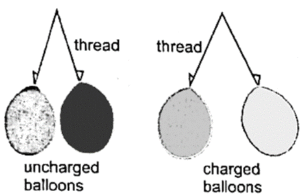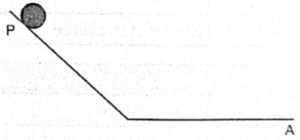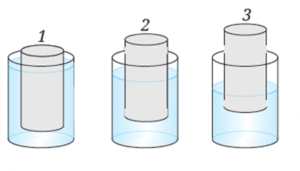Exploring Forces
NCERT-Class-8-Science (Curiosity)-Chapter-5
Solutions (Exercise + Intext)
NCERT Probe & Ponder Questions :
Question 1. Why does it feel harder to pedal a bicycle when going uphill than on flat ground?
- When we ride a bicycle uphill, we have to work against the pull of gravity, which tries to pull us back down.
- On flat ground, gravity acts straight down and doesn’t affect our forward movement much.
- But when the ground is sloped, part of gravity pulls us backward, so we need to push harder to move upward.
Question 2. Why is it easier to slip on a wet surface?
- It is easier to slip on a wet surface because water reduces friction between our feet and the ground.
- Friction is the force that helps us grip the surface while walking.
- When the surface is wet, a thin layer of water acts like a lubricant, making it smooth and slippery, so we lose our grip and can easily fall.
Question 3. Why do we feel ‘light’ or like we are ‘floating’ just after our swing reaches its highest point and begins to come down?
When you're on a swing and it reaches the highest point, your body is changing direction — from going up to coming down. At that moment:
- Your speed becomes almost zero.
- Gravity starts pulling you downward.
- But the swing rope hasn’t started pulling you down strongly yet.
- You feel light because there’s less force acting on your body. Gravity is pulling you, but nothing is pushing back yet.
So for a tiny moment, you’re not being pushed up or pulled down hard — it feels like you're floating!
Intext Questions :
Question 1. Is there any other contact force (other than muscular force)? (Page 67)
Yes, force of friction
Question 2. Is it essential for an object applying force on another object to always be in contact with it? (Page 69)
No, it is not essential for an object applying force on another object to always be in contact with it. Forces can be applied through contact (contact forces) or without direct contact (non-contact forces).
Question 3. The two similarly charged balloons repel each other whereas a charged balloon and the woollen cloth (with which the balloon was rubbed) attract each other (Activity 5.7). Does it mean that there are two kinds of electrical charges? (Page 71)
Yes, there are two types of electric charge: positive charge and negative charge.
These charges are fundamental properties of matter.
Question 4. Why do all the objects fall towards the Earth? Is there any force which acts on them? What exerts this force? (Page 72)
(i) All objects fall towards the Earth because of a force called gravity.
(ii) Yes, there is a force acting on any object in the universe, and it is called gravity.
(iii) Gravity is a force of attraction that exists between any two objects with mass.
The Earth, due to its large mass, exerts a gravitational force on all objects near it, pulling them towards its center.
Question 5. Does the Earth pull every object with equal force? (Page 72)
Not exactly, — Earth pulls all objects with gravity, but not with equal force. Here's a simple explanation:
- Gravity acts on all objects, but the force depends on their mass.
- Heavier objects (like a big rock) are pulled with more force.
- Lighter objects (like a feather) are pulled with less force.
Question 6. What is the difference between weight and mass? (Page 75)
Mass is the amount of matter in an object. Weight is the downward force acting upon an object due to gravity. On planet Earth, the two quantities are proportional.
Comparison Table :
| Feature | Mass | Weight |
| Definition | Amount of matter in an object | Gravitational force pulling the object |
| Constancy | Same everywhere (Earth, Moon, etc.) | Changes with location (depends on gravity) |
| SI Unit | Kilogram (kg) or gram (g) | Newton (N) |
| Measured By | Beam balance | Spring balance |
Question 7. If we place some objects on water, some of them float, while others fall to the bottom. The gravitational force of the Earth is acting on all objects, then why don't all objects fall to the bottom? (Page 76)
Gravity pulls all objects down. But whether an object floats or sinks in water depends on two forces:
(i) Gravitational Force : Pulls everything downward towards Earth.
(ii) Buoyant Force (Upward Push by Water) : Water pushes upward on objects placed in it. This is called buoyancy.
- If buoyant force is stronger than gravity → object floats.
- If gravity is stronger than buoyant force → object sinks.
This depends on the density of the object:
- Objects with a density lower than water experience a stronger buoyant force, causing them to float,
- Objects with a higher density experience a weaker buoyant force and sink.
Example :
- A plastic ball floats because it’s light and water pushes it up.
- A stone sinks because it’s heavy and water can’t push it up enough.
Activity Questions :
Activity 5.3: Let Us Investigate (Page 67)
- Take an object with a flat base (such as an empty lunch box/ geometry box/ a notebook) and place it on a table or floor.
- Gently push it and observe. Does it stop after travelling some distance? Is there a force acting on it which brings it to rest?
- Now repeat by pushing the object in the opposite direction. Does it stop again after travelling some distance?
- Yes, the object will stop after moving a certain distance when pushed on a table or floor. This is due to the force of friction, which opposes the motion of the object and eventually brings it to rest.
- When the object is pushed in the opposite direction, it will again stop after a certain distance due to the same frictional force.
Activity 5.8: Let Us Observe (Page 71)
- Take a ball and throw it vertically upwards. Does it come down?
- Now throw it again, but this time harder. Does it still fall back down to the ground?
Think about different situations around you where any object thrown up in any direction, finally falls or comes back to the ground or floor.
- When we throw a ball upward, it goes up for a while.
- But gravity is always pulling it downward.
- So after reaching the highest point, the ball slows down, stops for a moment, and then falls back.
Earth’s gravity acts on everything, all the time. It pulls objects towards the ground, no matter which direction they were thrown.
Even if you throw it harder, it just goes higher, but gravity still pulls it back.
Real-Life Examples Around us :
- A cricket ball hit high in the air — it comes down.
- A mango falling from a tree — it drops to the ground.
- A paper plane — it glides but eventually lands.
- A rocket — even it falls back unless it escapes Earth’s gravity.
Keep The Curiosity Alive :
Question 1. Match items in Column A with the items in Column B.
| Column A (Type of force) | Column B (Example) | ||
| (i) | Muscular force | (a) | A cricket ball stopping on its own just before touching the boundary line |
| (ii) | Magnetic force | (b) | A child lifting a school bag |
| (iii) | Frictional force | (c) | A fruit falling from a tree |
| (iv) | Gravitational force | (d) | Balloon rubbed on woollen cloth attracting hair strands |
| (v) | Electrostatic force | (e) | A compass needle pointing North |
| Column A (Type of force) | Column B (Example) | ||
| (i) | Muscular force | (b) | A child lifting a school bag |
| (ii) | Magnetic force | (e) | A compass needle pointing North |
| (iii) | Frictional force | (a) | A cricket ball stopping on its own just before touching the boundary line |
| (iv) | Gravitational force | (c) | A fruit falling from a tree |
| (v) | Electrostatic force | (d) | Balloon rubbed on woollen cloth attracting hair strands |
Question 2. State whether the following statements are True or False.
(i) A force is always required to change the speed of motion of an object.
True: A force is indeed always required to change the speed of motion of an object. If there is no force acting on an object it will maintain its current speed and direction (unless it's already at rest in which case it will stay at rest).
(ii) Due to friction, the speed of the ball rolling on a flat ground increases.
False: Friction opposes motion, so it will actually decreases the speed of a rolling ball.
(iii) There is no force between two charged objects placed at a small distance apart.
False: There is a force between charged objects. This force can be attractive or repulsive depending on the charges. But it is always present when charges are close to each other.
Question 3. Two balloons rubbed with a woollen cloth are brought near each other. What would happen and why?
Question 4. When you drop a coin in a glass of water, it sinks, but when you place a bigger wooden block in water, it floats. Explain.
- A coin sinks in water because its density (mass per unit volume) is greater than that of water.
- A wooden block floats because its density is less than that of water, causing it to be buoyed up by the water.
Question 5. If a ball is thrown upwards, it slows down, stops momentarily, and then falls back to the ground. Name the forces acting on the ball and specify their directions.
(i) During its upward motion
(ii) During its downward motion
(iü) At its topmost position
When a ball is thrown upwards, the only force acting on it throughout its entire motion is gravity, which pulls it downwards.
However depending on the motion of the ball, the direction of this force relative to the ball's velocity changes
- During its upward motion: The force of gravity acts downward, opposing the motion of the ball, causing it to slow down.
- During its downward motion: The force of gravity is still downwards, but now it aligns with the ball's direction of motion, accelerating it downwards.
- At its topmost position: The ball has zero velocity, meaning its momentarily stationary. At this point, the force of gravity is still downwards, but since the ball is not moving upwards or downwards, it has no net effect on the ball's motion.
Question 6. A ball is released from the point P and moves along an inclined plane and then along a horizontal surface as shown in the Fig. It comes to stop at the point A on the horizontal surface. Think of a way so that when the ball is released from the same point P, it stops (i) before the point A (ii) after crossing the point A.
The ball's motion is governed by the forces of gravity and friction.
Ball's Motion on Inclined and Horizontal Surfaces :
- Inclined plane: Gravity pulls the ball downward along the slope, causing it to accelerate.
- Horizontal surface: Gravity acts downward, but it doesn’t move the ball forward. Here, friction is the main force that slows the ball down.
(i) Stopping before A: Increasing friction on the horizontal surface will cause the ball to decelerate more rapidly, meaning it will come to a stop sooner, potentially before reaching point A.
(ii) Stopping after A: Decreasing friction on the horizontal surface will reduce the deceleration, allowing the ball to travel further before losing all its kinetic energy and stopping.
Question 7. Why do we sometimes slip on smooth surfaces like ice or polished floors? Explain.
- Friction is the force that helps our feet grip the ground when we walk.
- Smooth surfaces like ice or polished floors have fewer irregularities, so friction is very low. This makes it hard for our shoes to grip — so we slide and may lose balance.
- Role of Water on Ice : A thin layer of water on ice acts like a lubricant. It reduces friction even more, making the surface extra slippery.
Question 8. Is any force being applied to an object in a non-uniform motion?
Yes for an object to be in non-uniform motion, a force must be acting upon it. Non-uniform motion also known as accelerated motion means the object's velocity is changing, either in speed or direction or both. This change in velocity require a force to be applied.
Question 9. The weight of an object on the Moon becomes one-sixth of its weight on the Earth. What causes this change? Does the mass of the object also become one-sixth of its mass on the Earth?
- The change in object's weight on the moon compared to Earth is due to the difference in gravitational force.
- The moon's gravity is significantly weaker than Earth's, roughly one sixth as strong.
- However the mass of an object remains the same regardless of location; only weight changes with gravitational pull.
Question 10. Three objects 1, 2, and 3 of the same size and shape but made of different materials are placed in the water. They dip to different depths as shown in Fig. If the weights of the three objects 1, 2, and 3 are w1, w2, and w3, respectively, then
(i) w1 = w2 = w3
(ii) w1 > w2 > w3
(iii) w2 > w3 > w1
(iv) w3 > w1 > w2
The correct answer is: (ii) w1 > w2 > w3
Explanation :
- All three objects are same in size and shape, so their volume is equal.
- They are made of different materials, so their densities and weights are different.
- In water, the deeper an object sinks, the heavier it is (more weight = more gravitational force = more depth).
- Since they dip to different depths, their weights must be different.
In fig.,
- Object 1 is the deepest meaning it displaces the most water.
- Object 2 is less deep than object 1 but deeper than object 3.
- Object 3 is the least deep, meaning it displaces the least amount of water.
So, the object that sinks the most has the highest weight, and the one that floats the most has the least weight.
Key Features of Kitabcd Exam Master :
|
Click on below links to get PDF from store
PDF : Curiosity-Chapter-5-Exploring Forces– Notes
PDF : Curiosity-Chapter-5-Exploring Forces– Exam Master
Main Page : NCERT-Class-8-Science (Curiosity) – All chapters notes, solutions, videos, test, pdf.
Previous Chapter : Chapter-3- Health: The Ultimate Treasure – Online Notes
Next Chapter : Chapter-5- Exploring Forces – Online Notes



We reply to valid query.